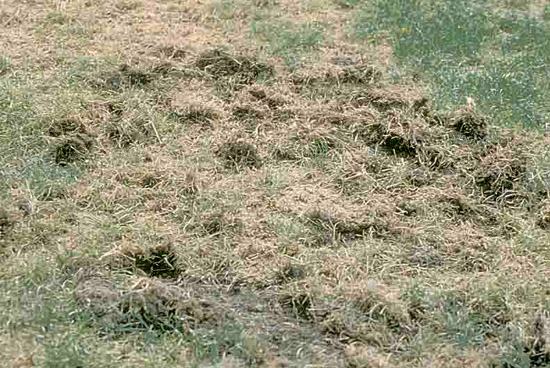Issue 11, July 12, 2013
White Grubs
With the light adult Japanese beetle emergence this year in much of the state, and the continuing periodic rains in most of the state, white grub numbers are likely to be low this year in most areas. Because masked chafer grubs are better able to survive the dry soils and high soil temperatures that we had last summer, they are likely to be more numerous this year. However, in most areas where Japanese beetles, northern masked chafers, and southern masked chafers occur together, the Japanese beetles tend to crowd them out of the prime, irrigated, turf areas.
This means that masked chafer populations in Illinois have been low for many years and do not have the numbers to take full advantage of a dry year. In other words, grub numbers should be low this year, but there is likely to be a higher percentage of masked chafer grubs over Japanese beetle grubs.
With the high, periodic rains, essentially all turf and soil is green enough and moist enough, respectively, to be attractive for egg-laying. So although the few adults present will lay many eggs and their larvae will have a high rate of survival, most areas will have small numbers of grubs per square foot. There will be areas of the state where Japanese beetle adults are numerous this year with grub populations high enough to warrant treatment.
There will also be spotty damage in the rest of the state. In years like this, it is common to have spots of a couple hundred square feet with high grub numbers and damage, while the rest of the lawn will have low numbers that do not cause obvious damage. Under these conditions, it is prudent to preventatively treat turf areas that usually have high numbers of grubs and to wait on many turf areas.
These non-treated areas can be scouted in August and curative spot treatments applied. The grubs do not hatch until late July in southern Illinois to early August in northern Illinois, so there will be no grubs to scout until then.
It is likely that fairways, greens and tees will warrant preventative treatment but roughs will not. Lawn clients that are very particular about even minor turf damage, and those that seem to always have high grub numbers should be treated preventatively, but take a wait and see approach for other clients.
Areas with a historical high incidence of damage from white grub feeding by raccoons, skunks, armadillos, and birds should be treated preventatively. In a wet year, white grub numbers of one to three per square foot are common. This is well below the ten to twelve per square foot to usually cause turf damage, but high enough to attack the above predators.

Skunk Feeding Damage
Insecticides recommended for preventative application in July are chlorantroniliprole (Acelepryn), clothianidin (Arena), imidacloprid (Merit), or thiamethoxam (Meridian).
Author:
Phil Nixon